Determination of Solar-Surface-Area-to-Volume Ratio: Early Design Stage Solar Performance Assessment of Buildings
Abstract
:1. Introduction
- (1)
- A building that promotes solar heat gain;
- (2)
- A low surface-to-volume ratio to reduce conductive heat flow;
- (3)
- A tight building envelope to reduce infiltration.
2. Background
2.1. Overview of the Currently Used Building Shape Indicators Related to Heat Losses
2.2. Solar Energy in Relation to Commonly Used Building Indicators
2.3. Solar Town Planning Space-Time Constructs
3. Approach and Methods
3.1. Boundary Conditions Determining the Solar-Surface-Area-to-Volume-Ratio
3.2. Determination of the Solar-Surface-Area-to-Volume Ratio
3.3. Mathematical Models of Solar Irradiation
- -
- -
- Kittler and Mikler’s mathematical model [35].
3.4. Solar-Surface-Area-to-Volume Ratio
4. Algorithm of Solar-Surface-Area-to-Volume Ratio
5. Evaluation of the Model House under Different Site-Specific Conditions and Time Intervals
6. Comparison with the Surface-Area-to-Volume Ratio
6.1. Ideal Shape for Solar-Surface-Area-to-Volume Ratio
6.2. Ideal Shape for Both Indicators
7. Case Study: Verification of the Solar Performance Indicator on Existing Buildings
7.1. Input Data and Calculation Presets
7.2. Calculation Results
8. Discussion
9. Conclusions
Author Contributions
Funding
Data Availability Statement
Conflicts of Interest
References
- Climate and Environmental Emergency—Thursday. 28 November 2019. Available online: https://www.europarl.europa.eu/doceo/document/TA-9-2019-0078_EN.html (accessed on 19 December 2022).
- What Is Carbon Neutrality and How Can It Be Achieved by 2050?|News|European Parliament. Available online: https://www.europarl.europa.eu/news/en/headlines/society/20190926STO62270/what-is-carbon-neutrality-and-how-can-it-be-achieved-by-2050 (accessed on 19 December 2022).
- Potenciál Budov v Znižovaní Emisií Uhlíka je Veľký. SKGBC. Available online: https://skgbc.eu/portal/potencial-budov-v-znizovani-emisii-uhlika-je-velky/ (accessed on 19 December 2022).
- Gupta, V. Thermal Efficiency of Building Clusters: An Index for Non-Air-Conditioned Buildings in Hot Climates. In Energy and Urban Built Form; Elsevier: Amsterdam, The Netherlands, 1987; pp. 133–145. ISBN 978-0-408-00891-4. [Google Scholar]
- Mahdavi, A.; Brahme, R.; Mathew, P. The “LEK”—Concept and Its Applicability for the Energy Analysis of Commercial Buildings. Build. Environ. 1996, 31, 409–415. [Google Scholar] [CrossRef]
- Gurtekin, A.; Mahdavi, A. Performance-Guided Explorations in the Thermal Design Space. In Research in Building Physics Proceedings of the Second International Conference on Building Physics, Leuven, Belgium, 14–18 September 2003; Carmeliet, J., Hens, H.S.L.C., Vermeir, G., Eds.; CRC Press: Boca Raton, FL, USA, 2020; ISBN 978-1-00-010814-9. [Google Scholar]
- Markus, T.A.; Morris, E.N. Buildings, Climate, and Energy; Pitman Pub: London, UK; Marshfield, MA, USA, 1980; ISBN 978-0-273-00266-6. [Google Scholar]
- Mahdavi, A.; Gurtekin, B. Computational Support for the Generation and Exploration of the Design-Performance Space. In Proceedings of the IBPSA Conference, Rio de Janeiro, Brazil, 13–15 August 2001. [Google Scholar]
- Mahdavi, A.; Gurtekin, B.; Hartkopf, V.; Loftness, V. Shapes, Numbers, Perception: Aspects and Dimensions of the Design-Performance Space. In Proceedings of the 6th International Conference: Design and Decision Support Systems in Architecture, Ellecom, The Netherlands, 7–10 July 2002. [Google Scholar]
- Aksoy, U.T.; Inalli, M. Impacts of Some Building Passive Design Parameters on Heating Demand for a Cold Region. Build. Environ. 2006, 41, 1742–1754. [Google Scholar] [CrossRef]
- Bostancioğlu, E. Effect of Building Shape on a Residential Building’s Construction, Energy and Life Cycle Costs. Archit. Sci. Rev. 2010, 53, 441–467. [Google Scholar] [CrossRef]
- Gonzalo, R.; Habermann, K.J. Energy-Efficient Architecture: Basics for Planning and Construction; Birkhäuser-Publishers for Architecture: Basel, Switzerland; Boston, MA, USA, 2006; ISBN 978-3-7643-7253-8. [Google Scholar]
- Hegger, M.; Institut für Internationale Architektur-Dokumentation (Eds.) Energy Manual: Sustainable Architecture; Birkhäuser: Basel, Switzerland; Boston, MA, USA; Munich, Germany, 2008; ISBN 978-3-7643-8830-0. [Google Scholar]
- Depecker, P.; Menezo, C.; Virgone, J.; Lepers, S. Design of Buildings Shape and Energetic Consumption. Build. Environ. 2001, 36, 627–635. [Google Scholar] [CrossRef]
- Ourghi, R.; Al-Anzi, A.; Krarti, M. A Simplified Analysis Method to Predict the Impact of Shape on Annual Energy Use for Office Buildings. Energy Convers. Manag. 2007, 48, 300–305. [Google Scholar] [CrossRef]
- Parasonis, J.; Keizikas, A.; Endriukaitytė, A.; Kalibatienė, D. Architectural Solutions to Increase the Energy Efficiency of Buildings. J. Civ. Eng. Manag. 2012, 18, 71–80. [Google Scholar] [CrossRef]
- Tuhus-Dubrow, D.; Krarti, M. Genetic-Algorithm Based Approach to Optimize Building Envelope Design for Residential Buildings. Build. Environ. 2010, 45, 1574–1581. [Google Scholar] [CrossRef]
- Treberspurg, M. Neues Bauen Mit der Sonne: Ansätze zu Einer Klimagerechten Architektur; 2. Aktualisierte und Erweiterte Auflage; Springer: Wien, Germany, 1999; ISBN 978-3-211-82940-0. [Google Scholar]
- Treberspurg, M. Vom Standardgebäude Zum Haus Der Zukunft: Sind Wir Auf Dem Richtigen Weg? In Proceedings of the AEE—Arbeitsgemeinschaft Erneuerbare Energie: Nachhaltige Solare Gebäude—Ergebnisse aus dem IEA—Forschungsprogramm SHC Task 28, Wien, Germany, 26 March 2004; pp. 5/1–5/14. [Google Scholar]
- Pokorny, W. Die Entwurfsgütezahl von Solarhäusern. In Energie 80; W. Kohlhammer Verlag: Stuttgart, Germany, 1982; p. 3. [Google Scholar]
- Karasu, A. Concepts for Energy Savings in the Housing Sector of Bodrum, Turkey: Computer Based Analysis and Development of Future Settlements Using Renewable Energy; Univerlagtuberlin: Berlin, Germany, 2009. [Google Scholar]
- Everding, D.; Kloos, M. Solarer Städtebau: Vom Pilotprojekt Zum Planerischen Leitbild; Kohlhammer: Stuttgart, Germany, 2007; ISBN 978-3-17-017413-9. [Google Scholar]
- Knowles, R.L. Energy and Form: An Ecological Approach to Urban Growth; MIT Press: Cambridge, MA, USA, 1974; ISBN 978-0-262-11050-1. [Google Scholar]
- Knowles, R.L. Sun Rhythm Form; MIT Press: Cambridge, MA, USA, 1981; ISBN 978-0-262-61040-7. [Google Scholar]
- Los, S.; Pulitzer, N. L’architettura del Regionalismo Guida Alla Progettazione Bioclimatica Nel Trentino; Libro Usato Vintage: Trento, Italy, 1985. [Google Scholar]
- Capeluto, I.G.; Shaviv, E. On the Use of ‘Solar Volume’ for Determining the Urban Fabric. Sol. Energy 2001, 70, 275–280. [Google Scholar] [CrossRef]
- Kristl, Ž.; Krainer, A. Energy Evaluation of Urban Structure and Dimensioning of Building Site Using Iso-Shadow Method. Sol. Energy 2001, 70, 23–34. [Google Scholar] [CrossRef]
- Höhl, W. Generative Solar Design. Forum Plan. 2009, 11, 9–11. [Google Scholar]
- Schiler, M.; Uen-Fang, P. Solvelope: An Interactive Computer Program for Defining and Drawing Solar Envelopes. In Proceedings of the 18th National Passive Solar Conference—ASES, Washington, DC, USA, 22–28 April 1993. [Google Scholar]
- GOSOL—Das Solar + Energetische Städtebausimulationsprogramm. Available online: http://gosol.de/gosol.html (accessed on 19 December 2022).
- Czachura, A.; Gentile, N.; Kanters, J.; Wall, M. Identifying Potential Indicators of Neighbourhood Solar Access in Urban Planning. Buildings 2022, 12, 1575. [Google Scholar] [CrossRef]
- Morganti, M.; Salvati, A.; Coch, H.; Cecere, C. Urban Morphology Indicators for Solar Energy Analysis. Energy Procedia 2017, 134, 807–814. [Google Scholar] [CrossRef]
- Ladybug Tools|Ladybug. Available online: https://www.ladybug.tools/ladybug.html (accessed on 19 December 2022).
- Davidson, S. Grasshopper. Available online: https://www.grasshopper3d.com/ (accessed on 19 December 2022).
- Kittler, R.; Mikler, J. Základy Využívania Slnečného Žiarenia; VEDA—Vydavateľstvo Slovenskej Akadémie vied v Bratislave: Bratislava, Slovakia, 1986. [Google Scholar]
- Robinson, D.; Stone, A. Irradiation Modelling Made Simple: The Cumulative Sky Approach and Its Applications. In Proceedings of the PLEA 2004, Eindhoven, The Netherlands, 20 September 2004; Volume 2, pp. 1255–1259. [Google Scholar]
- Tregenza, P.R. Subdivision of the Sky Hemisphere for Luminance Measurements. Light. Res. Technol. 1987, 19, 13–14. [Google Scholar] [CrossRef]
- Perez, R.; Seals, R.; Michalsky, J. All-Weather Model for Sky Luminance Distribution—Preliminary Configuration and Validation. Sol. Energy 1993, 50, 235–245. [Google Scholar] [CrossRef]
- EnergyPlus. Available online: https://energyplus.net/weather (accessed on 19 December 2022).
- Gendaymtx.Pdf—Radsite. Available online: https://www.radiance-online.org/learning/documentation/manual-pages/pdfs/gendaymtx.pdf/view (accessed on 19 December 2022).
- Posted by David Rutten on 25 September 2010 at 9:00 am. Blog, V. Evolutionary Principles Applied to Problem Solving. Available online: https://www.grasshopper3d.com/profiles/blogs/evolutionary-principles (accessed on 19 December 2022).
- Remund, J.; Wald, L.; Lefèvre, M.; Ranchin, T.; Page, J. Worldwide Linke Turbidity Information. In Proceedings of the ISES Solar World Congress 2003, Göteborg, Sweden, 14–19 June 2003; International Solar Energy Society: Göteborg, Sweden, 2003. [Google Scholar]
- Directive 2010/31/EU of the European Parliament and of the Council of 19 May 2010 on the Energy Performance of Buildings (Recast). Available online: http://data.europa.eu/eli/dir/2010/31/oj/eng (accessed on 21 December 2022).
- STN 73 0540-2+Z1+Z2. Available online: https://normy.unms.sk/eshop/public/standard_detail.aspx?id=128945 (accessed on 21 December 2022).
- ÖNORM B 8110-6-1; Wärmeschutz im Hochbau—Teil 6-1: Grundlagen und Nachweisverfahren—Heizwärmebedarf und Kühlbedarf. Austrian Standards: Wien, Austria, 15 January 2019. Available online: https://shop.austrian-standards.at/action/de/public/details/648067/OENORM_B_8110-6-1_2019_01_15 (accessed on 21 December 2022).
- STN EN ISO 13790/NA. Available online: https://normy.unms.sk/eshop/public/standard_detail.aspx?id=110292 (accessed on 21 December 2022).
- Chmúrny, I. Tepelná Ochrana Budov, 1st ed.; Jaga Group: Bratislava, Slovakia, 2003; ISBN 80-88905-27-3. [Google Scholar]
- Riccabona, C.; Bednar, T.; Mezera, K. Baukonstruktionslehre. 4: Bauphysik, 7th ed.; Völlig neu Überarb. Aufl.; Manz Verl. Schulbuch: Wien, Germany, 2008; ISBN 978-3-7068-3270-0. [Google Scholar]
- Morgenstein, P. Typológia Solárneho Urbanizmu Energetická Kooperatívnosť Urbánnych Štruktúr, 1st ed.; Slovenská Technická Univerzita v Bratislave FA ÚEEA: Bratislava, Slovakia, 2013. [Google Scholar]
- Morgenstein, P.; Hajtmanek, R. Dataset—Case Study Ostredky 2022. Available online: https://figshare.com/articles/dataset/Dataset_-_Case_Study_Ostredky/21768338 (accessed on 22 December 2022).
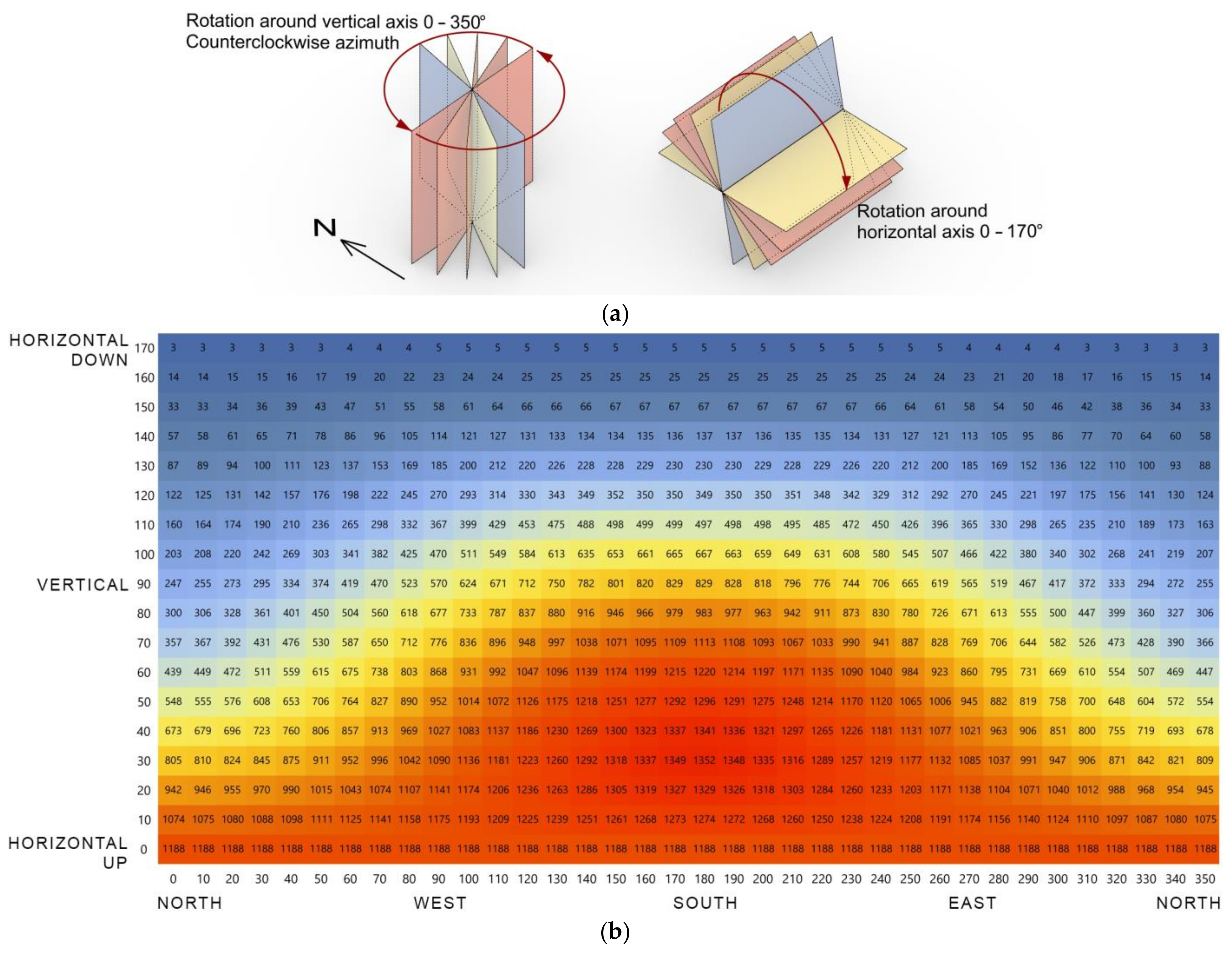

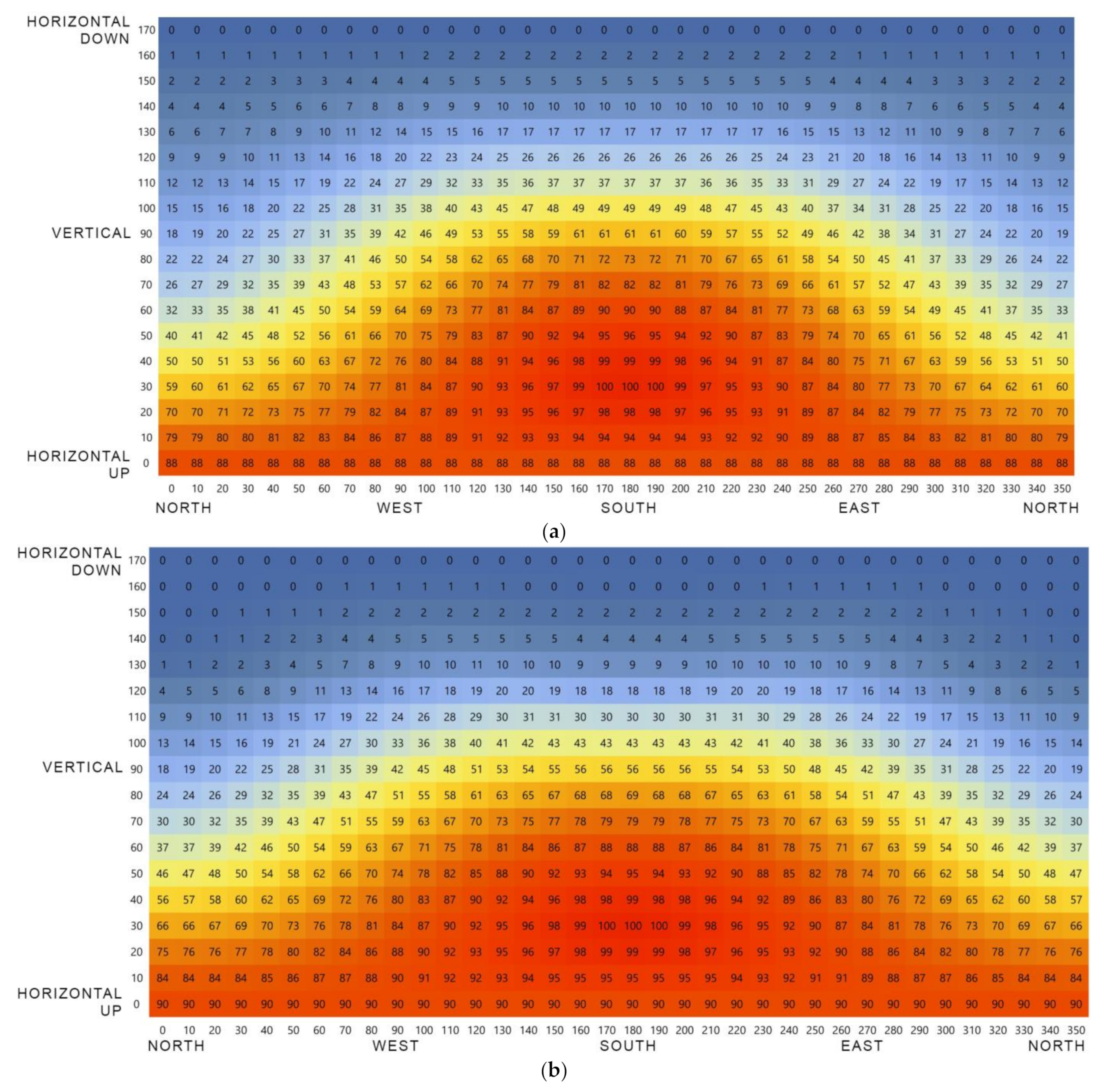
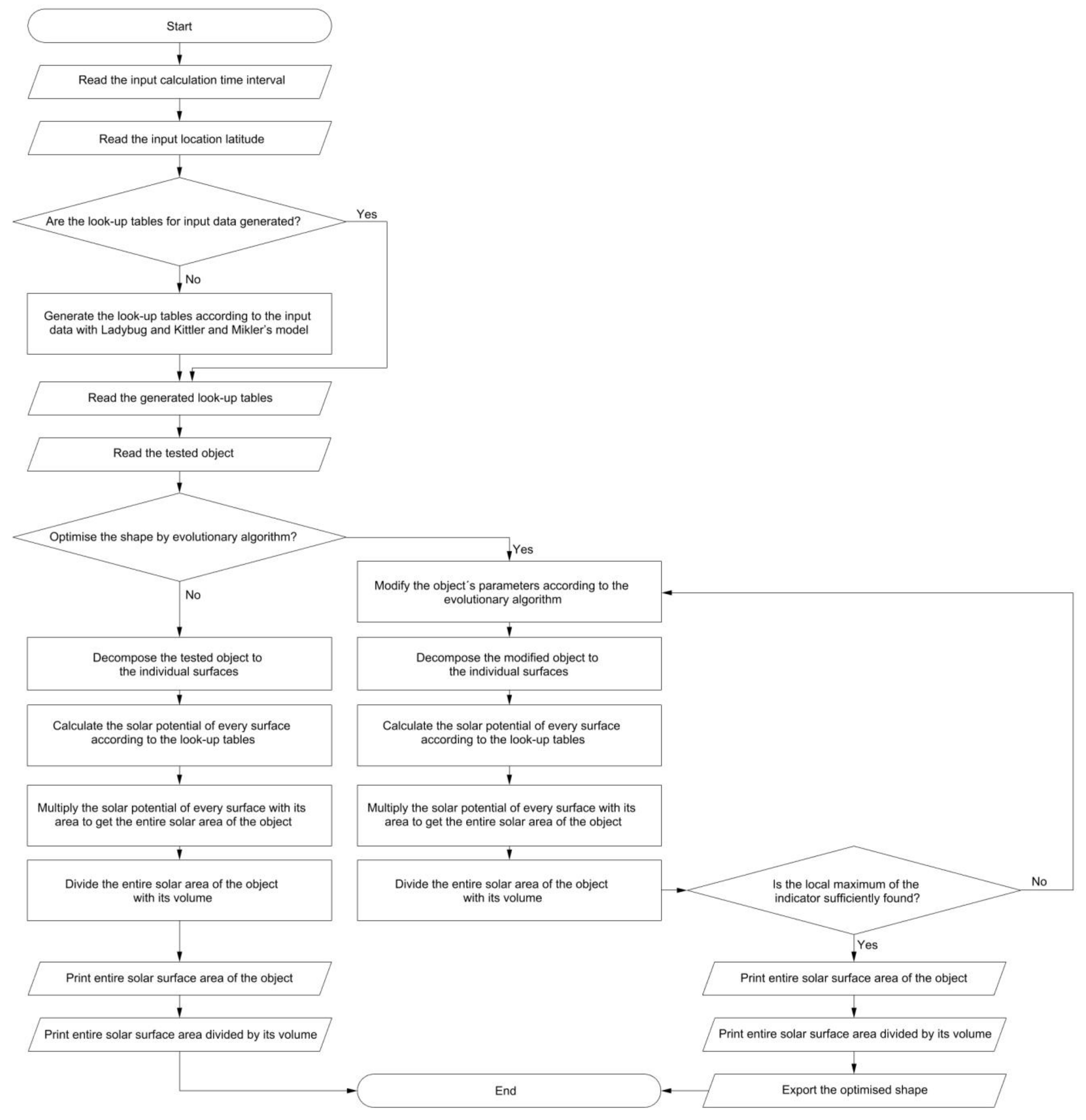
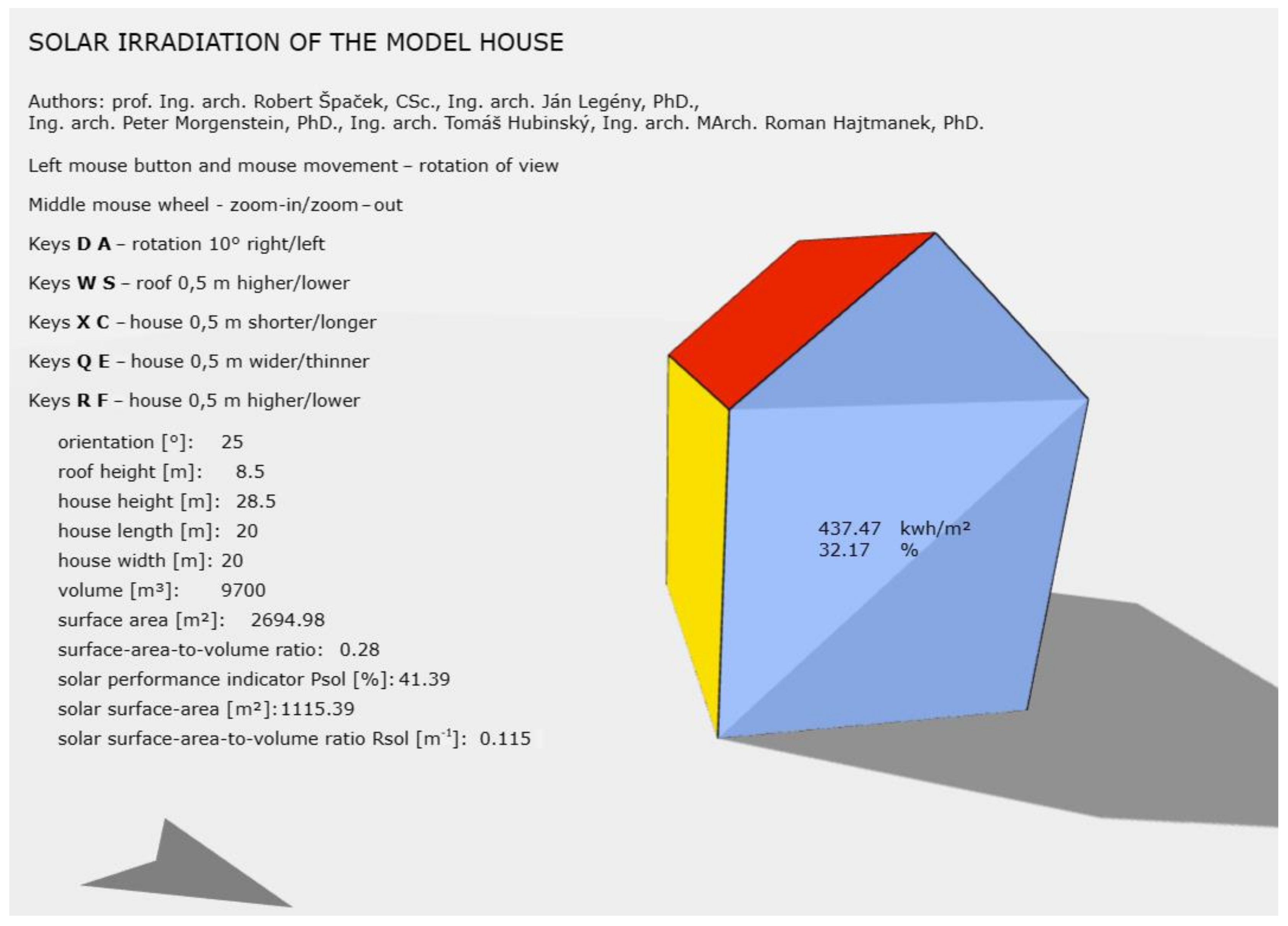

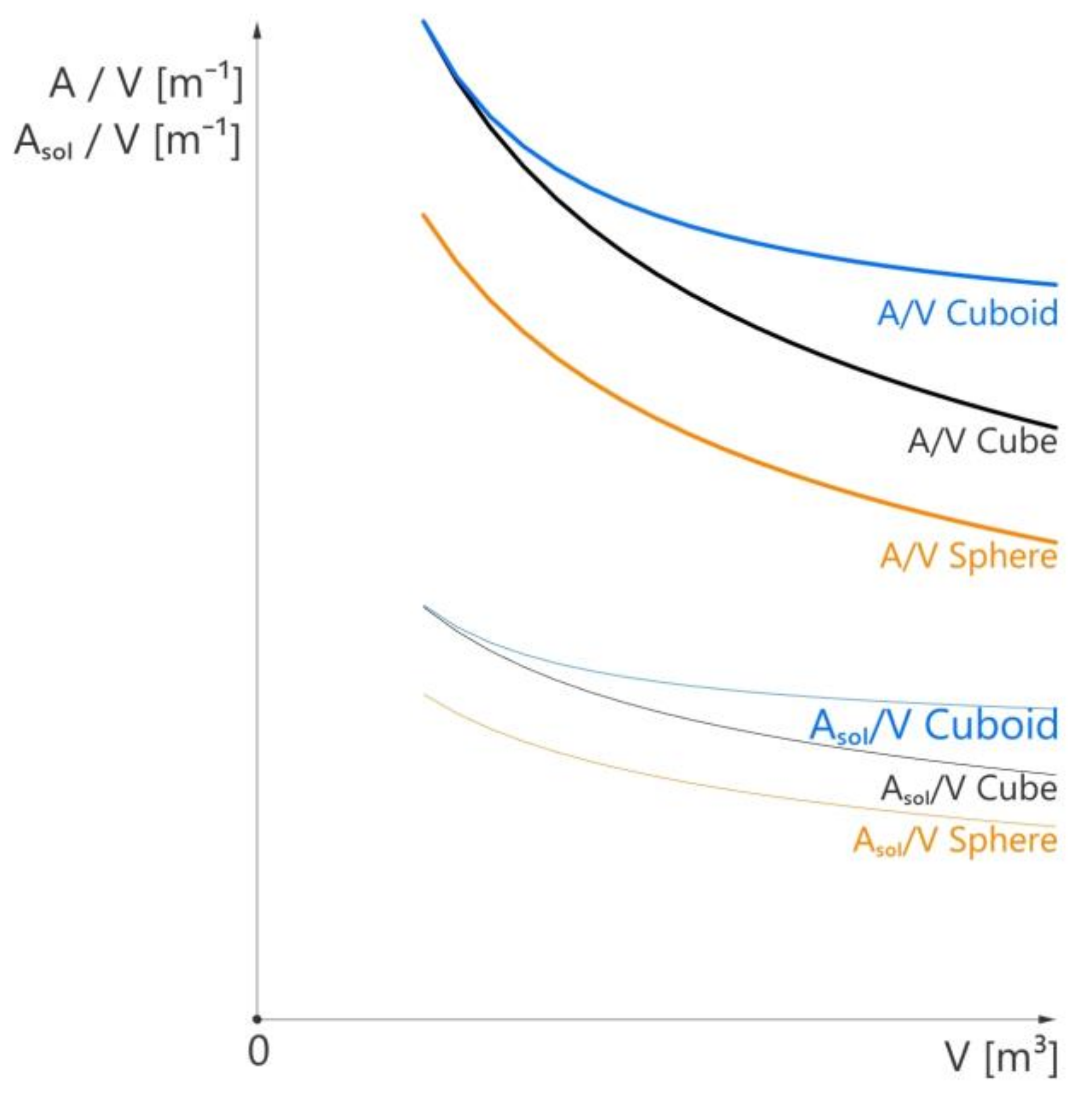
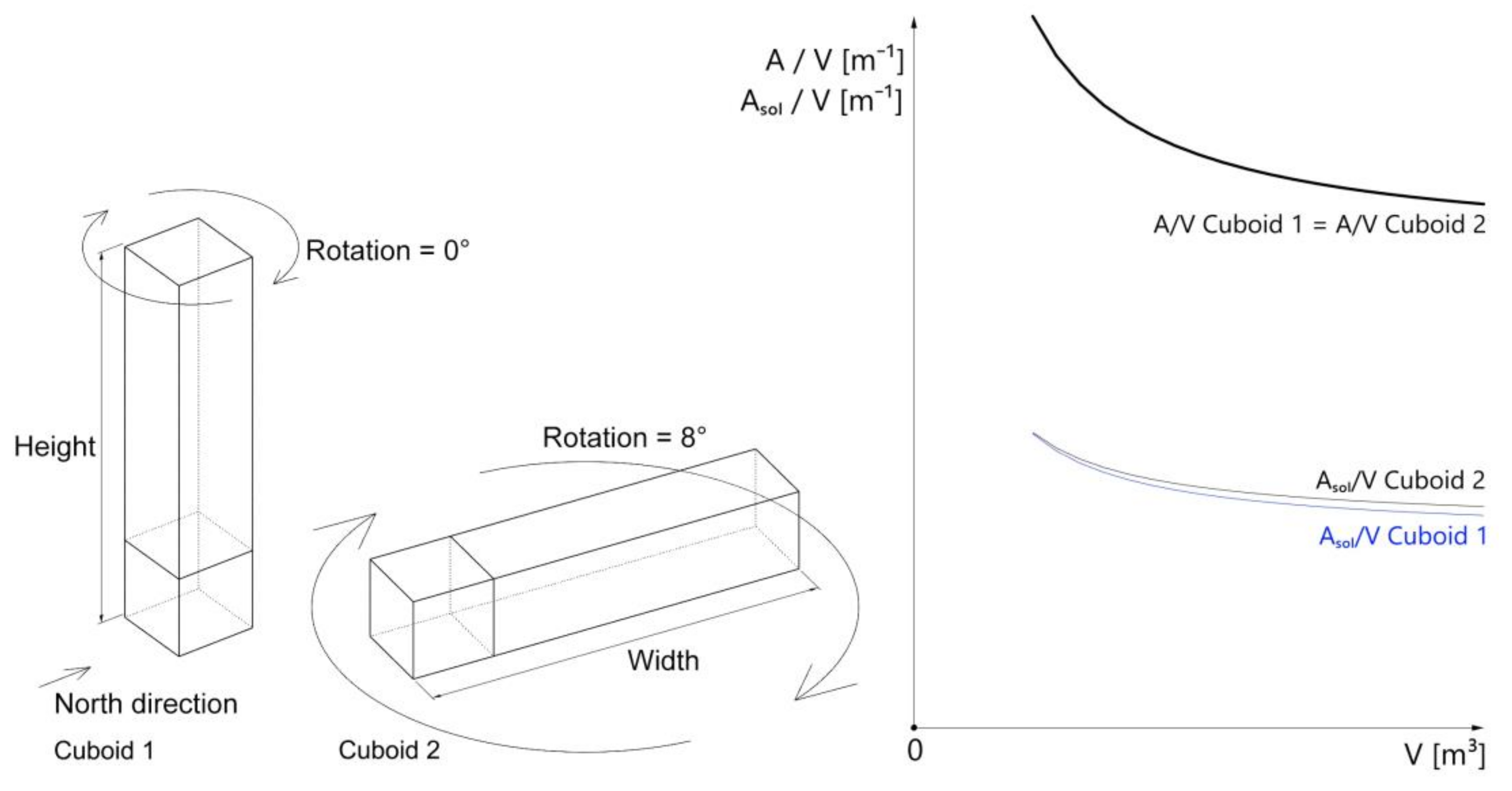
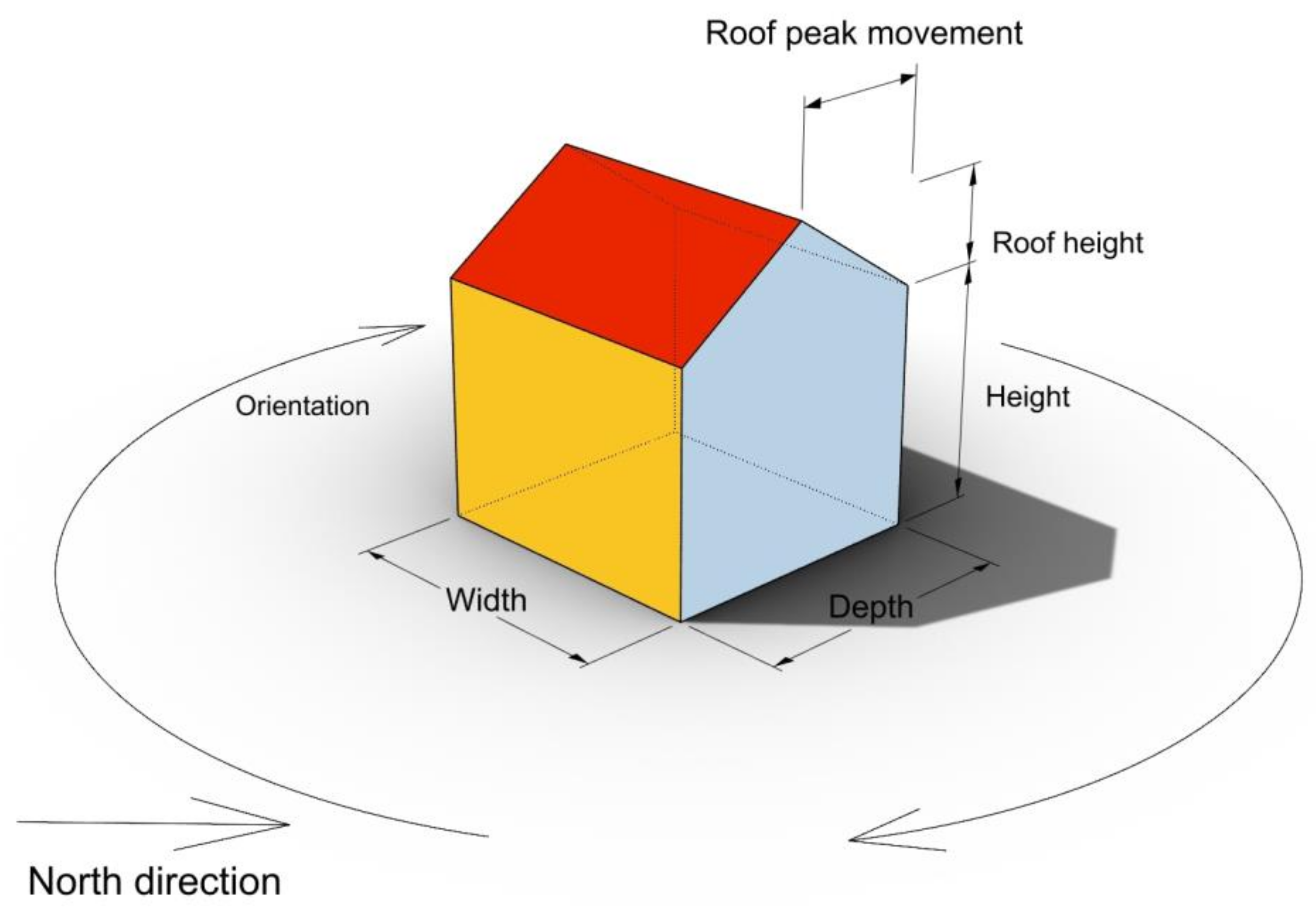

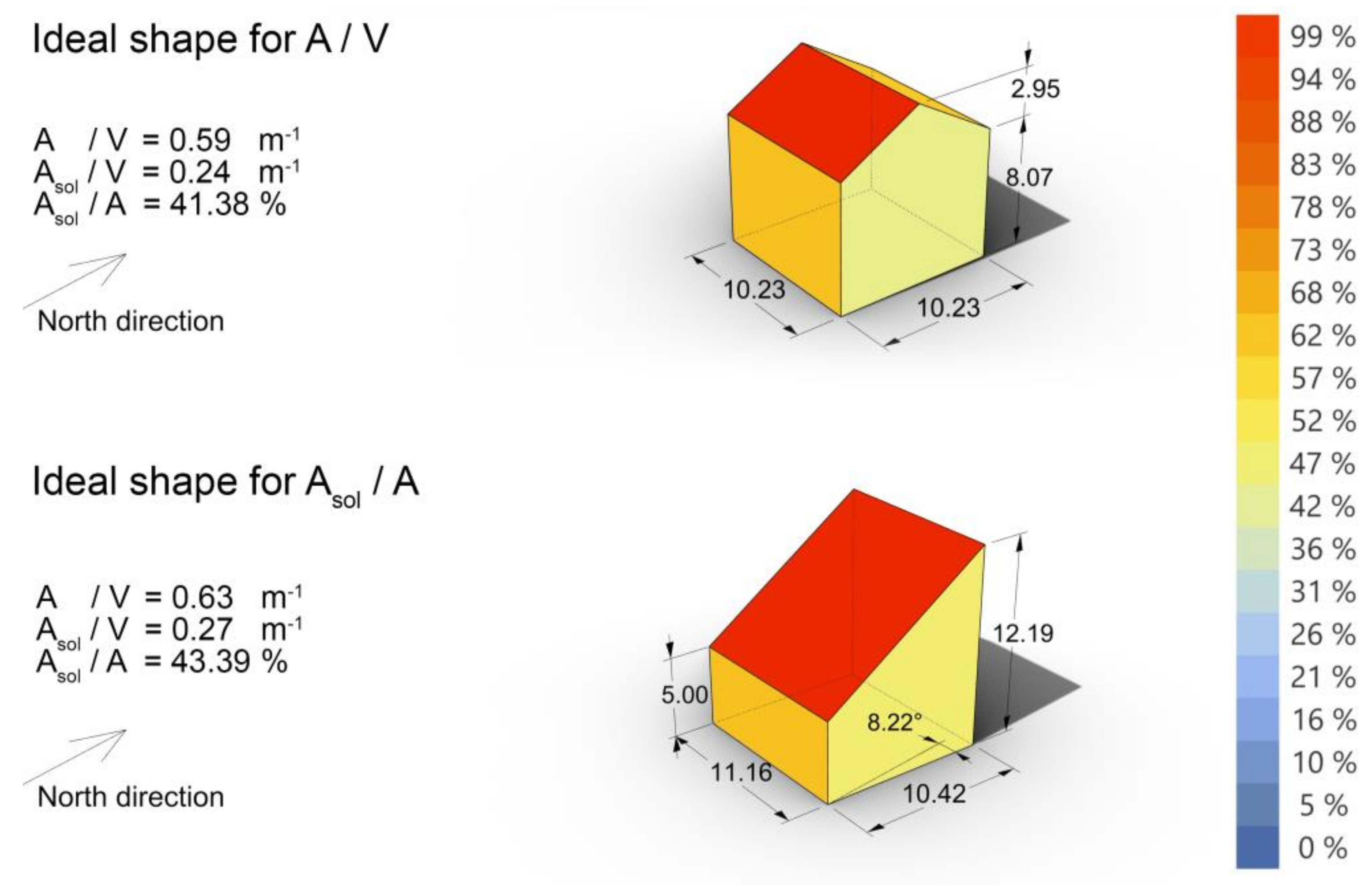


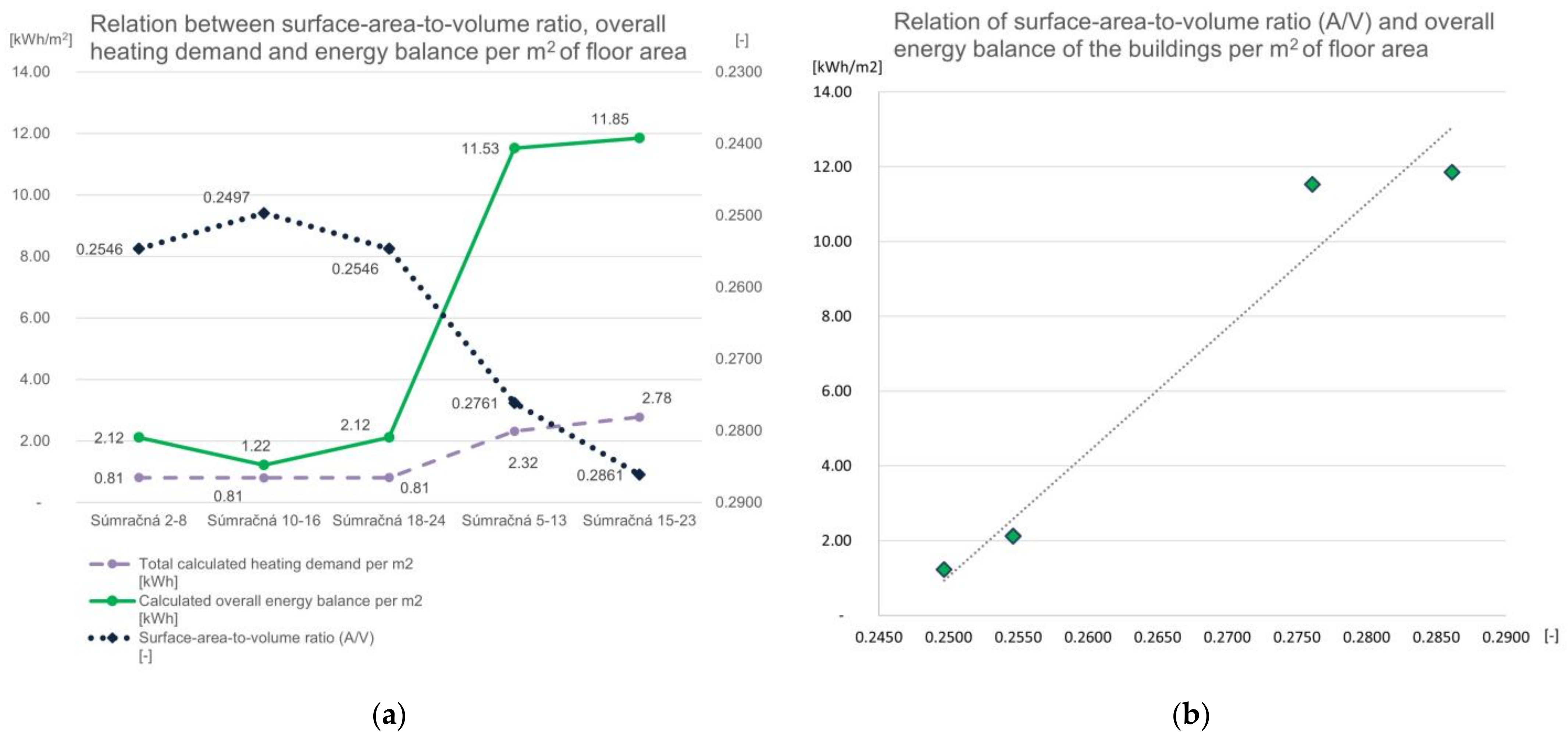

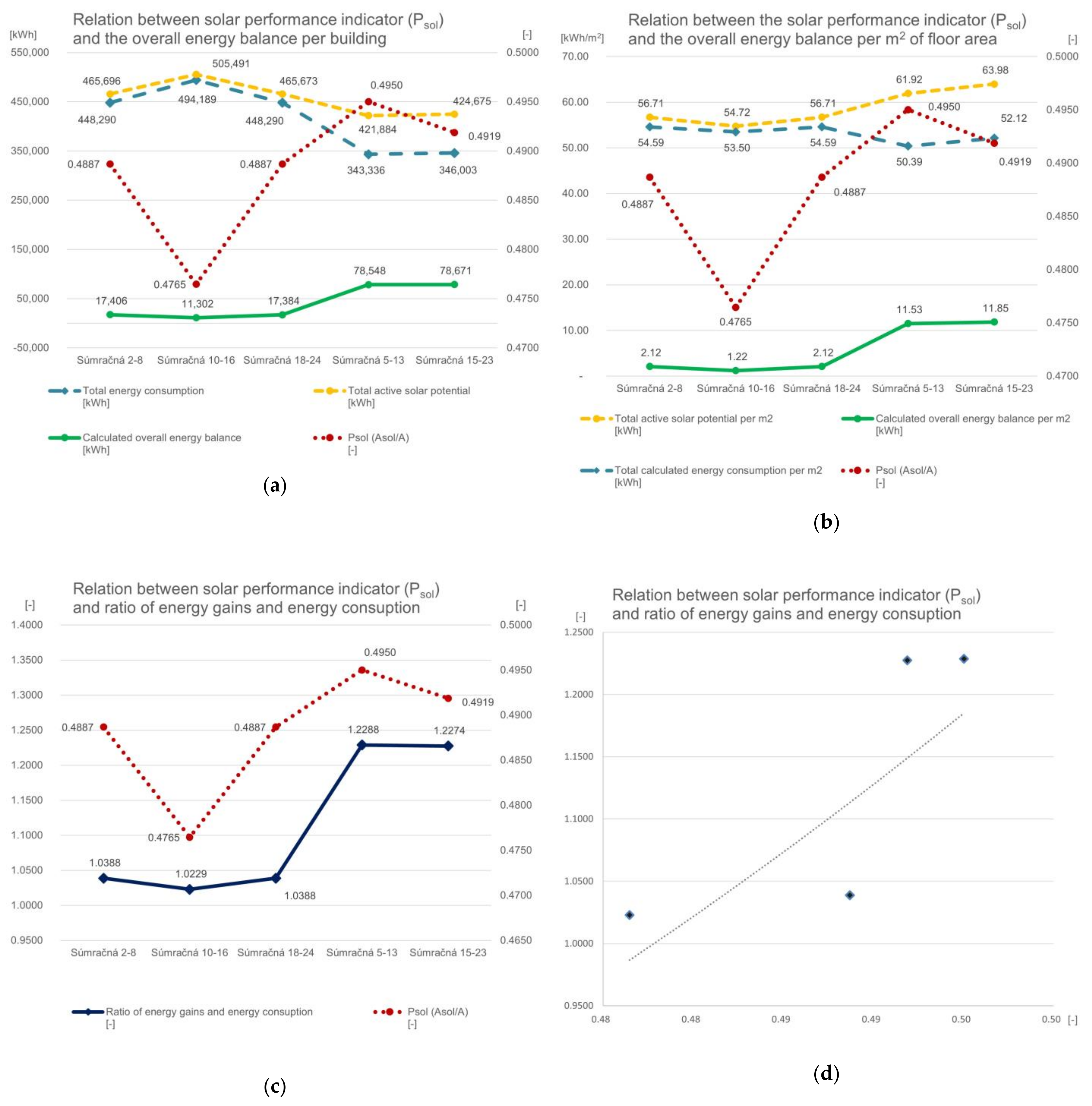
| Winter | Spring | Summer | Autumn | Annual |
|---|---|---|---|---|
| Look-up tables for Bratislava | ||||
 |  |  |  |  |
| Bratislava MAE with Ladybug [kWh/m2] | ||||
| 9.92 | 14.61 | 16.17 | 7.87 | 39.48 |
| Bratislava maximal irradiation [kWh/m2] | ||||
| 167.69 | 477.72 | 484.26 | 189.18 | 1298.78 |
| Look-up tables for Wagga Wagga | ||||
 |  |  |  |  |
| Wagga Wagga MAE with Ladybug [kWh/m2] | ||||
| 125.23 | 25.62 | 11.68 | 84.37 | 236.18 |
| Wagga Wagga maximal irradiation [kWh/m2] | ||||
| 375.18 | 355.27 | 372.95 | 398.43 | 1445.02 |
| Look-up tables for San Juan | ||||
 |  |  |  |  |
| San Juan MAE with Ladybug [kWh/m2] | ||||
| 79.81 | 28.1 | 30.34 | 60.67 | 196.19 |
| San Juan maximal irradiation [kWh/m2] | ||||
| 302.46 | 493.08 | 500.58 | 324.12 | 1600.87 |
| Annual | Season | |||||||||||
|---|---|---|---|---|---|---|---|---|---|---|---|---|
| Side number | 1 | 2 | 3 | 4 | 5 | 6 | Total annual | Winter | Spring | Summer | Autumn | |
| Volume [m3] | - | - | - | - | - | - | 9000.00 | - | - | - | - | |
| Area [m2] | 400.00 | 400.00 | 450.00 | 450.00 | 223.61 | 223.61 | 2147.22 | - | - | - | - | |
| Bratislava | Solar potential [%] | 22.35 | 55.29 | 50.53 | 31.42 | 97.97 | 68.61 | - | - | - | - | - |
| Solar surface area [m2] | 89.40 | 221.16 | 227.39 | 141.39 | 219.07 | 153.42 | 1051.82 | 133.59 | 384.35 | 388.00 | 145.39 | |
| Solar-surface-area-to-volume ratio [m−1] | - | - | - | - | - | - | 0.12 | 0.01 | 0.04 | 0.04 | 0.02 | |
| Wagga Wagga | Solar potential [%] | 55.86 | 21.42 | 29.78 | 49.83 | 66.40 | 97.68 | - | - | - | - | - |
| Solar surface area [m2] | 223.44 | 85.68 | 134.01 | 224.24 | 148.48 | 218.42 | 1034.26 | 270.64 | 233.46 | 243.04 | 286.31 | |
| Solar-surface-area-to- volume ratio [m−1] | - | - | - | - | - | - | 0.11 | 0.03 | 0.03 | 0.03 | 0.03 | |
| San Juan | Solar potential [%] | 27.76 | 36.79 | 40.03 | 35.17 | 95.05 | 86.77 | - | - | - | - | - |
| Solar surface area [m2] | 111.04 | 147.16 | 180.14 | 158.27 | 212.54 | 194.03 | 1003.17 | 192.86 | 300.48 | 303.60 | 204.72 | |
| Solar-surface-area-to- volume ratio [m−1] | - | - | - | - | - | - | 0.11 | 0.02 | 0.03 | 0.03 | 0.02 | |
| Building | Measured Average Heat Consumption 2011–13 (Heating Only) [kwh] | Calculated Average Heating Demand [kwh] | Calculated Hot Water Demand [kwh] | Calculated Cooling Demand [kwh] | Calculated Electricity Consumption [kwh] | Measured Total Average Heating Demand in 2011–13 [kWh/m2] | Calculated Total Avg. Heating Demand with Heat Transfer Coefficients Required before 2013 [kWh/m2] |
|---|---|---|---|---|---|---|---|
| Súmračná 2–8 | 650,241 | 374,299 | 143,080 | 2778 | 245,280 | 79.19 | 45.58 |
| Súmračná 10–16 | 405,278 | 424,177 | 157,133 | 3161 | 269,370 | 43.87 | 45.92 |
| Súmračná 18–24 | 350,185 | 374,305 | 143,080 | 2778 | 245,280 | 42.65 | 45.58 |
| Súmračná 5–13 | 355,296 | 362,511 | 102,200 | 3495 | 175,200 | 52.15 | 53.21 |
| Súmračná 15–23 | 420,000 | 372,798 | 102,200 | 3722 | 175,200 | 63.27 | 56.16 |
| Heat Transfer Coefficients (U) | Minimal Values Required before 2013 [W/m²·K] | Minimal Values Required since 2013 [W/m²·K] | Minimal Values Required since 2016 [W/m²·K] | Minimal Values Required since 2021 [W/m²·K] |
|---|---|---|---|---|
| Uwall | 0.35 | 0.32 | 0.22 | 0.15 |
| Uroof | 0.20 | 0.20 | 0.15 | 0.10 |
| Uground | 0.20 | 0.20 | 0.10 | 0.10 |
| Uwindow | 1.70 | 1.40 | 1.00 | 0.60 |
| Building | Calculated Average Heating Demand [kWh] | Calculated Hot Water Demand [kWh] | Calculated Cooling Demand [kWh] | Calculated Electricity Consumption [kWh] | Calculated PV Potential [kWh] | Calculated ST Potential [kWh] | Total Energy Consumption [kWh] | Total Active Solar Potential [kWh] | Calculated Overall Energy Balance [kWh] |
|---|---|---|---|---|---|---|---|---|---|
| Súmračná 2–8 | 6656 | 143,080 | 53,273 | 245,280 | 250,693 | 165,257 | 448,290 | 415,950 | −32,340 |
| Súmračná 10–16 | 7451 | 157,133 | 60,236 | 269,370 | 266,327 | 180,907 | 494,189 | 447,234 | −46,956 |
| Súmračná 18–24 | 6659 | 143,080 | 53,271 | 245,280 | 250,686 | 165,251 | 448,290 | 415,937 | −32,353 |
| Súmračná 5–13 | 15,777 | 102,200 | 50,159 | 175,200 | 210,998 | 146,742 | 343,336 | 357,741 | +14,405 |
| Súmračná 15–23 | 18,449 | 102,200 | 50,154 | 175,200 | 206,919 | 144,251 | 346,003 | 351,170 | +5167 |
| Examined Building | Calculated Total Heating Demand per m2 of Floor Area [kWh] | Calculated Total Active Solar Potential per Building [kWh] | Calculated Total Active Solar Potential per m2 of Floor Area [kWh] | Calculated Overall Energy Balance per m2 Floor Area [kWh] | Surface-to-Volume Ratio (A/V) [-] | Asol Solar Surface Area Summarised [-] | Rsol Solar-Surface-to-Volume Ratio (Asol/V) [-] | Psol Solar Performance Indicator (Asol/A) [-] |
|---|---|---|---|---|---|---|---|---|
| Súmračná 2–8 | 0.81 | 465,696 | 56.71 | 2.12 | 0.2546 | 3012.98 | 0.1030 | 0.4887 |
| Súmračná 10–16 | 0.81 | 505,491 | 54.72 | 1.22 | 0.2497 | 3303.57 | 0.1004 | 0.4765 |
| Súmračná 18–24 | 0.81 | 465,673 | 56.71 | 2.12 | 0.2546 | 3012.98 | 0.1030 | 0.4887 |
| Súmračná 5–13 | 2.32 | 421,884 | 61.92 | 11.53 | 0.2761 | 2848.97 | 0.1174 | 0.4950 |
| Súmračná 15–23 | 2.78 | 424,675 | 63.98 | 11.85 | 0.2861 | 2874.71 | 0.1216 | 0.4919 |
Disclaimer/Publisher’s Note: The statements, opinions and data contained in all publications are solely those of the individual author(s) and contributor(s) and not of MDPI and/or the editor(s). MDPI and/or the editor(s) disclaim responsibility for any injury to people or property resulting from any ideas, methods, instructions or products referred to in the content. |
© 2023 by the authors. Licensee MDPI, Basel, Switzerland. This article is an open access article distributed under the terms and conditions of the Creative Commons Attribution (CC BY) license (https://creativecommons.org/licenses/by/4.0/).
Share and Cite
Hajtmanek, R.; Morgenstein, P.; Hubinský, T.; Legény, J.; Špaček, R. Determination of Solar-Surface-Area-to-Volume Ratio: Early Design Stage Solar Performance Assessment of Buildings. Buildings 2023, 13, 296. https://doi.org/10.3390/buildings13020296
Hajtmanek R, Morgenstein P, Hubinský T, Legény J, Špaček R. Determination of Solar-Surface-Area-to-Volume Ratio: Early Design Stage Solar Performance Assessment of Buildings. Buildings. 2023; 13(2):296. https://doi.org/10.3390/buildings13020296
Chicago/Turabian StyleHajtmanek, Roman, Peter Morgenstein, Tomáš Hubinský, Ján Legény, and Robert Špaček. 2023. "Determination of Solar-Surface-Area-to-Volume Ratio: Early Design Stage Solar Performance Assessment of Buildings" Buildings 13, no. 2: 296. https://doi.org/10.3390/buildings13020296
APA StyleHajtmanek, R., Morgenstein, P., Hubinský, T., Legény, J., & Špaček, R. (2023). Determination of Solar-Surface-Area-to-Volume Ratio: Early Design Stage Solar Performance Assessment of Buildings. Buildings, 13(2), 296. https://doi.org/10.3390/buildings13020296






